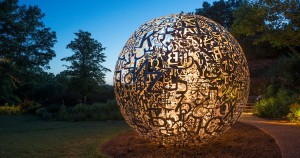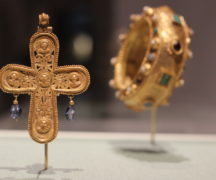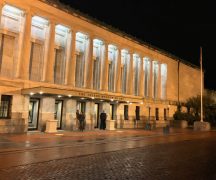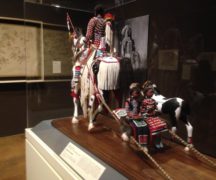From TOLEDO MUSEUM OF ART
Works by one of Spain’s most celebrated contemporary artists will stretch across the Toledo Museum of Art’s galleries and grounds when “Jaume Plensa: Human Landscape” opens June 17. The major exhibition, which continues through Nov. 6, spotlights Plensa’s sculptures, drawings, paintings and installations that explore the human body in relation to landscape and language.
Northwest Ohio is the final destination of this traveling show organized by the Cheekwood Botanical Garden & Museum of Art in Nashville, Tennessee, in partnership with the Frist Center for the Visual Arts. It’s also the last chance to see so many of these outstanding works in one place – in this case in the Museum’s Levis Galleries indoors and outside on the 36-acre campus.
“Jaume is one of the most important contemporary sculptors working today,” said Amy Gilman, Toledo Museum of Art associate director and curator of contemporary art. “He is a poet. He is very thoughtful about language, and he’s choosing to express that in this visual way. You leave his work having had a moment of reflection and thoughtfulness that is a hard thing to come by in the very data-driven and internet-connected world that we live in.”
Six large-scale sculptures and sculpture groups by Jaume Plensa (pronounced zhow-muh plens-sah) are positioned in various locations on the Museum’s campus while a selection of works on paper, including 18 drawings and 6 etchings, are on display in the Levis Galleries along with large-scale installations that hang on the walls and ceiling.
“The addition of Plensa’s sculptures to surroundings that are familiar will give our visitors an opportunity to experience the campus in a new way. And, given the immediate popularity of Plensa’s “Spiegel” when it was added to our collection, we believe the works themselves will really resonate with visitors,” Gilman said.
Visitors familiar with Spiegel, which was acquired by the Museum four years ago for the Welles Sculpture Garden, will instantly recognize Plensa’s singular style in Human Landscape.
“See No Evil, Hear No Evil, Speak No Evil” (2010) shows three human figures demonstrating the parable. But the bodies in Plensa’s version hang from the walls, floating, rather than remain firmly planted on the ground. To the artist, they serve as a reminder of our failure to use our senses.
In Paula, the female visage, altered and stretched, becomes the focus. This head is striking against the greenery of an outdoor landscape and juxtaposed with the Museum’s neoclassical building.
“Tradition says that our face is a gift to others,” Plensa said. “The face is the only part of our body that cannot be seen by ourselves – the soul’s portrait. [And] in my point of view, the head is the palace of dreams, the main ‘place’ in our body.”
Plensa will discuss the exhibition in a conversation with Gilman at 6 p.m. June 23 in the Peristyle. The program is open to the public free of charge.
Born in Barcelona, Spain, in 1955, Plensa is internationally recognized for his large figurative sculptures and installations that produce enchanting and mystifying visions of the human form as landscape. A significant portion of his work is located in public spaces of cities in Spain, France, Japan, England, Canada, the United States and other countries. The Crown Fountain, unveiled in Chicago’s Millennium Park in 2004, is considered to be one of his most brilliant works and led to many commissions, including Roots (2014) in Tokyo.
The Toledo Museum of Art showing of Jaume Plensa: Human Landscape is sponsored by ProMedica, the 2016 Exhibition Program Sponsor, and made possible in part by members of the Museum and a sustainability grant from the Ohio Arts Council.
A fully illustrated color exhibition catalogue can be purchased in the Museum Store or ordered online at tmastore.com.
Admission to the Museum and the exhibition is free. Parking is free for Museum members and $5 for non-members. For more information, visit toledomuseum.org.





